IDENTIFICATION
Scientific name:
Cornus mas
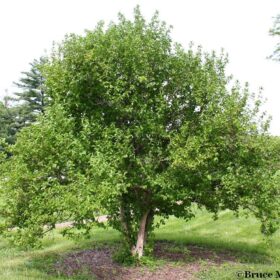
Italian common name:
Corniolo
Family:
Cornaceae
Origin:
South Western Asia, Southern Europe
Environment:
It lives in small groups in the clearings of broad-leaved forests, among the shrubs and hedges of the plateaus, up to about 1500 meters above sea level. Very adaptable plant, it resists the rigors of winter and scorching temperatures, in shady and cool but also arid and stony environments
Evergreen or deciduous:
deciduous
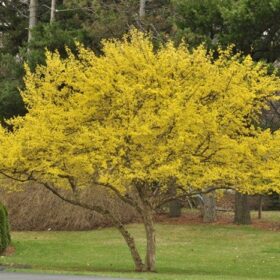
Toxicity:
not
PLANT RECOGNITION
Height:
2 – 7 meters
Width (extension):
2 – 4 meters
Habit:
rounded, very branched
Leaf:
simple, opposite, with a short and hairy petiole; the shape is ovate or rounded, intact and slightly wavy at the edges, sharp at the apex; 4-10 cm long, they are partially covered by fluff on both pages; they are green in color, lighter in the lower part; they have evident ribs in the center and 3 or 4 pairs of secondary ribs.
Flower:
hermaphrodites (i.e. they have both male and female organs for reproduction), in the shape of simple and short umbels, surrounded at the base by an envelope of 4 bracts (modified leaves that protect the flower), of a greenish color tinged with red, which develop before leafing. The corolla has 4 sharp petals, hairless (hairless), golden-yellow in colour.
Flowering: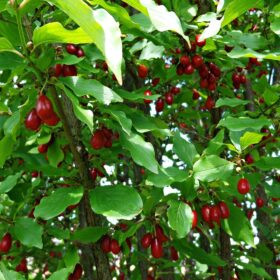
February – April
Fruit:
drupe (fleshy fruit), edible (edible), with a sour flavour, shaped like an olive or an oblong cherry, containing a single bony seed; it has a scarlet-red, coral red or even yellow color. The fruits ripen in August.
Trunk:
Twisted and knotty. Brown bark, peeling in small plaques that almost twist. The branches are short, first green then light brown.
Property:
both bark and fruit are good for you. They are in fact used in phytotherapy, thanks to their febrifugal and astringent properties. This makes the dogwood suitable as a remedy in cases of intestinal disorders and fevers of various kinds. The berries, rich in vitamin C, were once used to fight dysentery. The vitamin C contained in dogwood also has diuretic and toning properties. Additionally, dogwood extracts may have anti-infective and antimicrobial functions. Berries are also a cure-all for respiratory tract infections and joint pain.
Parfume: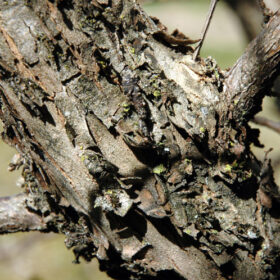
yes, slight smell of honey
NEED
Maintenance:
easy to maintain. For numerous branches, pruning must be taken care of if in a garden.
Light Exposure:
sun, partial shade
Soil type:
stony soils, particularly on calcareous bottoms, especially on hills, prefers dry, permeable soil, rich in humus.
Soil acidity:
pH 6,0 – 7,0
Italian climatic area:
widespread throughout the peninsula, but it is cultivated with more attention in the northern regions. The plant grows well up to 1,300 meters above sea level.
Need for water: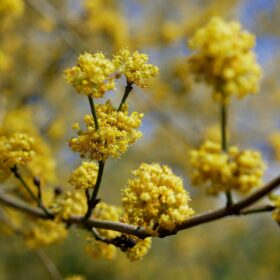
Rustic plant. Water during periods of drought.
Propagation:
by cutting by taking herbaceous cuttings in the first half of August, semi-woody cuttings in summer or woody cuttings in autumn. Removal of suckers in autumn.
Diseases:
leaf spots, crown canker, root rot, powdery mildew and leaf rust. Stressed plants may be susceptible to borers; and the leaf miner, hen and scale can also become more than just cosmetic problems.
Pruning:
It is not necessary but, if it must be done, it must be done during the cold season, before the plant begins to sprout. Remove dry and diseased branches and cut back older branches to encourage the growth of new shoots.
PARTICULARITY 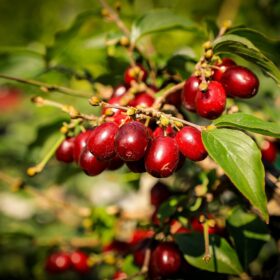
Cornus: [Cornaceae] from the Indo-European root kar to be hard, passed to the Latin cornus corno, to underline the hard and robust wood
Mas da mās, măris male, masculine to define a more robust species than another more delicate one, defined as female, feminine.
For members of the Serbian Orthodox community this plant has a sacred value. They collect the seeds on Christmas Eve and in the morning, as soon as they get up, they consume them with a sip of red wine, making the sign of the cross and hoping to stay in good health all year round. In fact they use to say “healthy as the dogwood” (Giardinoweb)
If you want to delve deeper into the sacred aspects of the plant go here
Annotations
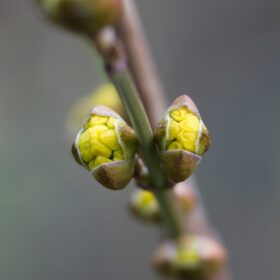
The dogwood is cultivated in gardens and allotments both as an ornamental plant and for its edible fruits. There are different varieties with red or yellow fruits, more or less large. It is a rustic shrub, it is not afraid of late frosts and resists attacks from many diseases
Dogwood berries are also a secret weapon against wrinkles and skin blemishes. Its astringent and purifying function allows you to use it as a real natural beauty remedy. Dogwood bark decoction can be used as a natural anti-wrinkle. Berry juice, combined with honey, lemon and sugar can be used as a scrub. The juice combined with aloe vera gel can also become a beauty mask for the hair.
This species has a deep connection with the city of Padua. When the convent of San Benedetto was founded, Abbot Giordano Forzatè (12th and 13th centuries) traced its boundaries with a dogwood stick which he then left firmly planted in the ground. Soon a tree grew from the stick.
The Trojan horse was made by the Greeks with dogwood from a forest sacred to Apollo located on Mount Ida.
The Gordian knot, which according to myth tied Gordium’s chariot to a post in the city of Gordium, was made of dogwood bark.
The Palatine Huts, found in 1948 in the Roman Forum in Rome, correspond to the sanctuary of the Casa Romuli, near which the sacred Cornelian tree grew, born after Romulus had thrown an auction from the Aventine to prove his prowess. The tip was stuck deep in the ground, right near the “future” huts, and none of those who tried to extract it succeeded. The earth was so fertile where it was stuck, that it produced shoots and then a large plant. This tree became sacred to the Romans and guarded by his successors as if it were one of the most sacred relics, so much so that it was protected with a wall.
In the kitchen:
The small red fruits are processed for the production of fruit juices and jams, excellent as an accompaniment to boiled meat, and to flavor some types of alcohol, such as grappa. The prices of these products are relatively high due to the low production and small alcohol content. It is preferable to taste the fruits that are fully ripe, which detach from the stem with a light touch of the hand or as soon as they fall.
DOGWOOD LIQUEUR RECIPE
• in a 2 liter hermetically sealed jar, place 500 g of fresh ripe fruit, well washed and dried, 400 g of sugar, the zest of a lemon, the peel and core of a Renetta apple from Canada, and up to one grappa finger under hem;
• close and expose to the sun;
• when the sugar has dissolved, place the jar in the dark and in a cool place to rest for 6 months
• then filter and bottle
FONTE AICG (e fasolipiante.com)
THE MONDO DEL GIARDINO ADVICE
The Dogwood is a small tree without great demands for attention, but generous in flowering and with beautiful and useful fruits. For a natural garden it is an excellent choice to promote biodiversity.
Now on horseback! Work awaits us! Our new wonderful outdoor space is about to be born!
GOOD WORK and…if you have any questions, write to info@ilmondodelgiardino.com
Image sources: thanks to Pixabay and many thanks to Goran Horvat for the social media photo and hose-dae jeung kim for the cover photo. Then in order of insertion ca.agev.info, Krzysztof Jaracz, actaplantarum.org, Annie, J_Blueberry, Ilona Ilyés, and Krzysztof Jaracz for the closing photo.



